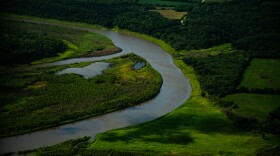The Polk County Board of Supervisors voted unanimously Tuesday to provide $200,000 to help maintain a network of water quality sensors in rivers and streams across Iowa.
The sensors are part of the Iowa Water Quality Information System and collect real-time data for nitrate, pH, flow and temperature, among other parameters. The University of Iowa’s IIHR—Hydroscience & Engineering lab currently manages 60 sensors, according to IIHR Director Larry Weber. The U.S. Geological Survey maintains 12 in Iowa waterways, and the U.S. Department of Agriculture has eight for specific projects, he added.
After the Iowa Legislature diverted funding in 2023, the Walton Family Foundation and Iowa Nutrient Research Center provided bridge funds to keep the University of Iowa sensors running through June of 2026.
Polk County’s dollars will support the network after the June cutoff, according to Polk County Board of Supervisors Chair Matt McCoy. The county is using its remaining funds from the American Rescue Plan Act and the Central Iowa Source Water Research Assessment budget.
“Supporting this important work is vital to the state of Iowa, and making sure that Polk County is leading in this effort and addressing issues of water quality is an important part of our job as local elected officials,” McCoy said.
The funding from Polk County represents a third of the $600,000 annual budget for the University of Iowa’s water monitoring program. McCoy said he’s hopeful other counties, including Linn and Johnson, will contribute funding to avoid disruptions to the network next year.
Restoring long-term funding through the Legislature is a priority, as well, McCoy said.

John Swanson, Polk County’s water resources supervisor, leads a division of conservationists who work to improve water quality in the county and a dozen more counties upstream. This includes urban stormwater management, residential rain gardens and partnerships to add wetlands and cover crops.
“We need to keep monitoring. We need to keep looking at the data, keep using that data to say, ‘Where can we be most efficient with our projects?’” Swanson said. “This is an opportunity for us to invest and keep that monitoring system going for at least another year.”
Richard Leopold, director of Polk County Conservation, added that these practices require time, energy and money. Long, continuous periods of data are key to making sure investments are paying off and for tracking trends to protect people's health.
McCoy said he recently learned about the Iowa division of the Izaak Walton League of America launching a GoFundMe campaign for the water monitoring program.
“All of us can do something … to improve our water system and the quality of our water, and for that matter, recreation and health in our state,” McCoy said.





